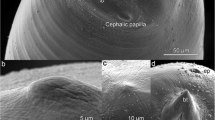Abstract
Since Culex pipiens quinquefasciatus is the main vector of lymphatic filariasis in tropics and subtropics, the identification and quantification of this mosquito is an important task. Scanning electron microscopy reveals that morphological changes during larval development as the number of comb scale varies greatly and their complexity increases from first to the fourth instar. Also, their structures are more complex with a varying number of subapical denticles. The amount of pecten shows modifications at different larval instars with regard to the number and complexity of their spines. The pecten teeth increase in their number and complexity during development. The number of lateral palatal brush filaments increases during larval development from the first to the fourth instar. The ventral brush of the abdominal segment X in the first and second instars is composed of two respectively three pairs of setae while the third and fourth instars have four pairs of sturdy setae.








Similar content being viewed by others
References
Amer A, Mehlhorn H (2006) The sensilla of Aedes and Anopheles mosquitoes and their importance in repellency. Parasitol Res 99:491–499
Anthony TG, Harbach RE, Kitching IJ (1999) Phylogeny of the Pyretophorus Series of Anopheles subgenus Cellia (Diptera: Culicidae). Syst Entomol 24:193–205
Beckett A, Read ND, Porter R (1984) Variation in fungal spore dimensions in relation to preparatory techniques for light microscopy and scanning electron microscopy. J Microsc 136:87–95
Bowen MF (1995) Sensilla basiconica (grooved pegs) on antennae of female mosquitoes: electrophysiology and morphology. Entomol Exp Appl 77:233–238
Clark-Gil S, Darsie RF (1983) The mosquitoes of Guatemala, their identification and binomics. Mosq Syst 15:151–284
Correa-da-Silva MS, Fampa P, Lessa LP, Silva ER, Mallet JRS, Saraiva EMB, Motta MCM (2006) Colonization of Aedes aegypti midgut by the endosymbiont-bearing trypanosomatid Blastocrithidia culicis. Parasitol Res 99:384–391
Dahl C, Sahl G, Grawe J, Johannisson A, Amenus H (1993) Differential particle uptake by larvae of three mosquito species (Diptera: Culicidae). J Med Entomol 30:537–543
Eskelinen S, Saukko P (1983) Effects of glutaldehyde and critical point drying on the shape and size of erythrocytes in isotonic and hypotonic media. J Microsc 130:63–71
Linley JR (1989a) Scanning electron microscopy of the egg of Aedes (Protomacleaya) triseriatus (Diptera: Culicidae). J Med Entomol 26:474–478
Linley JR (1989b) Comparative fine structure of the eggs of Aedes albopictus, Ae. aegypti and Ae.bahamensis (Diptera: Culicidae). J Med Entomol 26:510–521
Linley JR, Clark GG (1989) Egg of Aedes (Gymnometopa) mediovittatus (Diptera: Culicidae). J Med Entomol 26:252–255
Linley JR, Craig GB (1994) Morphology of long- and short-day eggs of Aedes atropalpus and A. epactius (Diptera: Culicidae). J Med Entomol 31:855–867
Meis JFGM, Ponnudurai T (1987) Ultrastructural studies on the interaction of Plasmodium falciparum ookinetes with the midgut epithelium of Anopheles stephensi mosquitoes. Parasitol Res 73:500–506
Rashed SS, Mulla MS (1990) Comparative functional morphology of the mouth brushes mosquito larvae (Diptera: Culicidae). J Med Entomol 27:429–439
Schaper S, Hernandez-Chavarria F (2006) Scanning electron microscopy of the four larval instars of the Dengue fever vector Aedes aegypti (Diptera: Culicidae). Rev Biol Trop 54(3):847–852
Service MW, Duzak D, Linley JR (1997) SEM examination of the eggs of five British Aedes species. J Am Mosq Control Assoc 13:47–65
Somboon P, Yamniam K, Walton C (2009) Scanning electron microscopy of the cibarial armature of the Anopheles dirus complex (Diptera: Culicidae). Parasitol Res 40(5):937–941
Sutcliffe JF (1994) Sensory bases of attractancy: morphology of mosquito olfactory sensilla: a review. J Am Mosq Control Assoc 10:309–315
Author information
Authors and Affiliations
Corresponding author
Rights and permissions
About this article
Cite this article
Adham, F.K., Mehlhorn, H. & Yamany, A.S. Scanning electron microscopy of the four larval instars of the lymphatic filariasis vector Culex quinquefasciatus (Say) (Diptera: Culicidae). Parasitol Res 112, 2307–2312 (2013). https://doi.org/10.1007/s00436-013-3393-4
Received:
Accepted:
Published:
Issue Date:
DOI: https://doi.org/10.1007/s00436-013-3393-4




